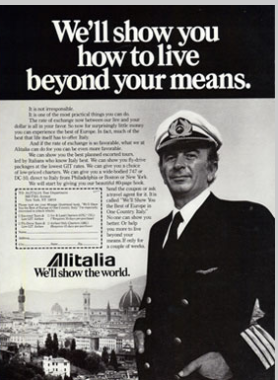The Independent's journalism is supported by our readers. When you purchase through links on our site, we may earn commission.
This is why Alitalia is failing
Plane talk: Etihad could be about to end its love affair with the Italian airline

Your support helps us to tell the story
From reproductive rights to climate change to Big Tech, The Independent is on the ground when the story is developing. Whether it's investigating the financials of Elon Musk's pro-Trump PAC or producing our latest documentary, 'The A Word', which shines a light on the American women fighting for reproductive rights, we know how important it is to parse out the facts from the messaging.
At such a critical moment in US history, we need reporters on the ground. Your donation allows us to keep sending journalists to speak to both sides of the story.
The Independent is trusted by Americans across the entire political spectrum. And unlike many other quality news outlets, we choose not to lock Americans out of our reporting and analysis with paywalls. We believe quality journalism should be available to everyone, paid for by those who can afford it.
Your support makes all the difference.Alitalia is looking for love. Well, a rich suitor at any rate.
The Italian national airline continues to defy gravity and stay afloat, as it has done for years, pumped up by about €12m a week in support from various generous benefactors. The Italian finance minister has just “lent” Alitalia around €400m, which should be enough to keep it going through the winter even though union members roundly rejected a rescue plan that had been hammered out by management and unions.
La vita was more dolce for a time in the 20th century, when leisure and business travel was expanding. As recently as 1992, Alitalia and British Airways could keep a straight face and insist that, yes, the lowest possible return fare between London and Rome was £250. Anyone with the temerity not to stay over a Saturday night would pay double.
It would be unfair to single out Italy, and Alitalia; a quarter-century ago the same story played out in Spain, Germany and Scandinavia. But while Iberia, Lufthansa and SAS have adapted, painfully and slowly, to low-cost competition, Alitalia has stubbornly refused to believe the world has changed.
And, in some ways, it hasn’t. I am indebted to anna.aero, the airline network news and analysis website, for digging up an Alitalia marketing poster of a suave airline captain and the message “We’ll show you how to live beyond your means.”

The anna.aero project began in 2007, before the economic crisis had bitten, and even then one of the earliest stories was contemplated the possible consequences if Alitalia had collapsed. Many analysts, journalists and economists have expended plenty of effort over the past decade looking at exactly that subject.
But for as long as Alitalia has a hotline to benefactors and a monopoly on key domestic routes, as I wrote last week it is probably too Italian to fail. Alitalia has the prime link from Milan Linate to Rome Fiumicino to itself; anna.aero says: “Linate has been artificially constrained for many years and is also the most convenient airport for downtown Milan.”
The Italian airline also faces no competition to Rome’s main airport from Venice, Genoa and Trieste. For the Rome-Venice route, I checked a whole range of dates, including a wet Wednesday in mid-November, and the lowest fare remained stubbornly at €70 one way. For a 250-mile hop, that price looks way too high.
Most “legacy” airlines have embraced competition. They may envy the lower cost bases of budget rivals such as easyJet and Ryanair, but they adapt to survive and, sometimes, thrive. Not Alitalia. Instead, it looks for partners who can help it withstand the heat. Two decades ago that was the Dutch airline KLM, later augmented by Air France.
Then, in the summer of 2014, news emerged from Abu Dhabi: Etihad pumped in around half a billion pounds and acquired 49 per cent of Alitalia. The cunning plan of the Gulf airline: “Build a reinvigorated Alitalia as a competitive, sustainably profitable business.” Those were the words of James Hogan, Etihad President and Chief Executive.
He added: “We believe in Alitalia. It is great brand with enormous potential. With the right level of capitalisation and a strong, strategic business plan, we have confidence the airline can be turned around and repositioned as a premium global airline once again.
“Alitalia is the perfect ambassador for Italy and all that it represents. As we revitalise the brand, the airline will increasingly embody all that we recognise as quintessentially Italian – the history, culture, food and fashion. It must be an airline of which Italians can be proud.”
“However ultimately it has to work as a business and the goal is for sustainable profitability from 2017.”
That went well, then. The Italian partner burned through the cash at a phenomenal rate, and nearly three years on is as far from being “a competitive, sustainably profitable business” as ever it was. But as Alitalia continues to fly on the benevolence of the Italian taxpayer, Mr Hogan was replaced this week at the helm of Etihad.
The man who has taken over, Ray Gammell, is conducting a “strategic review”. I imagine Alitalia's bosses expect a swift break-up, and are already looking for the next donor, sorry partner. Quite likely it will be that old flame, the Italian state.
Meanwhile, it’s business as usual at the Italian airline — which has even launched a new route this month, connecting Rome with Kiev seven nights a week — out at 11pm. Getting people to the Ukrainian capital at 2.50am doesn’t look the biggest earner in aviation, but the decades have shown that’s not necessarily a concern for “the perfect ambassador for Italy”.
Join our commenting forum
Join thought-provoking conversations, follow other Independent readers and see their replies
Comments